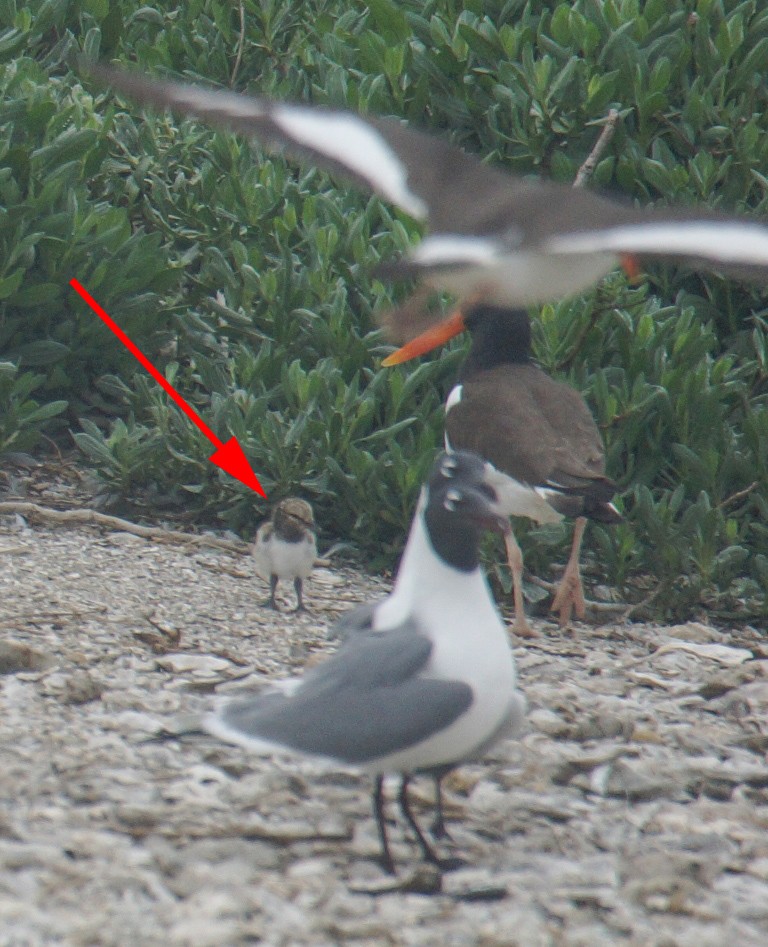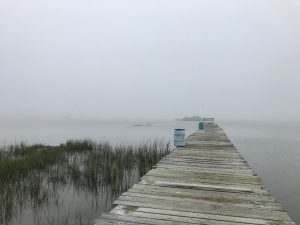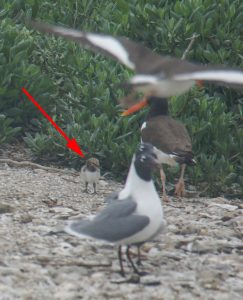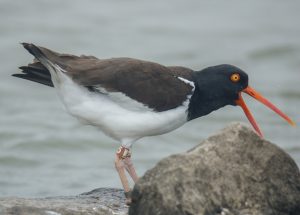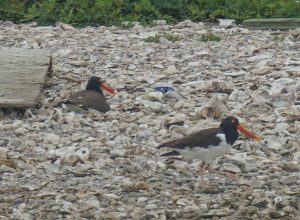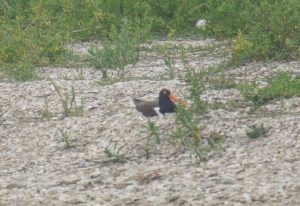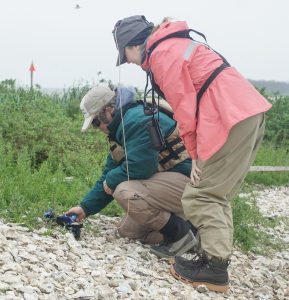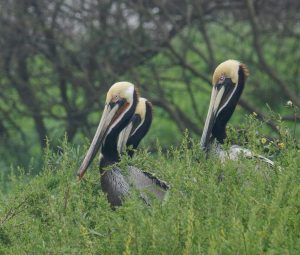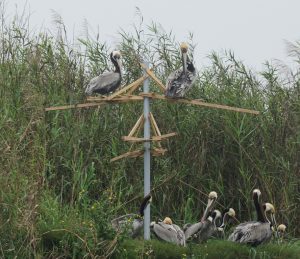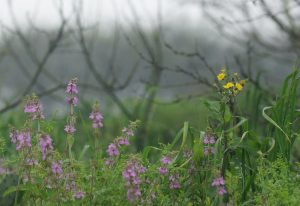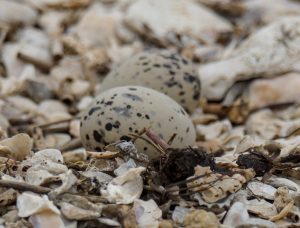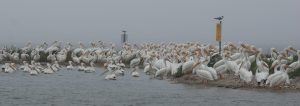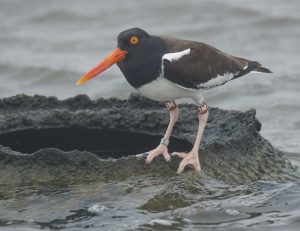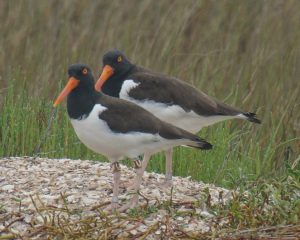By Susan Heath
Chicks! We’ve got chicks. Ok well maybe just one chick but it’s so cute! I know you can’t wait to see it! Ok take a couple deep breathes, calm down, and I’ll tell you the story. We had to rearrange the schedule this week due to the weather so we went to West Galveston Bay on Tuesday instead of Wednesday. I was joined by Alan Wilde, Taylor Bennett, and Kaitie Braddock. The forecast called for some rain early in the morning so when I got up on Tuesday I checked the weather to see if we needed to delay our start time. Happily no rain! Sadly, there was FOG. Again. I think FOG must be an acronym and the first letter stands for a curse word because that is what slipped out of my mouth when I saw that it was foggy yet again. The forecast was for it to clear by 10:00 so we delayed an hour and arrived at the boat ramp at 9:30. We were greeted by this.
Hello weather people. Have you looked outside? I really wasn’t up for picking our way around in the fog again so we waited to see if it would clear. Slowly, very slowly it did seem to be getting clearer. A little after 10:00, they changed the forecast to say it would clear by noon. I wasn’t sure I trusted them but since it seemed to be getting clearer, we waited until we could see as far as the houses at Tiki and then set out. The boat ramp oystercatcher pair had been on the dock earlier so we knew they didn’t have a nest. They came and circled us calling as we pulled away from the boat ramp. I guess they are still upset at our trapping attempt two weeks ago. Get over it guys and go lay some eggs!
We have to cross a big expanse of Galveston Bay to get to Swan Lake so I had wanted to go there first because the wind was supposed to pick up later in the day. The fog nixed that plan though so we headed out to Jones Bay. FR & unbanded were not at home so we proceeded to check on P3 & unbanded. Their nest is up high in some vegetation so we can’t see the incubating adult. We saw only one along the shoreline though so I was willing to assume they were incubating and move on without disturbing them but then an adult flushed out of the vegetation any way. Ok still incubating. We were pulling away when Taylor said “I see a chick”. What?! Alan grabbed his camera and Kaitie and I grabbed our binoculars and all eyes were on the island. Sure enough there was small chick scurrying around clearly startled by the adult that had flushed. Alan snapped some photos and we skedaddled out of there so the chick could get back under cover. I suspect the adult was brooding the chick on the nest because the other egg wasn’t hatched yet but we don’t know for sure. At any rate, we know there’s at least one chick!
On that high note we proceeded to check on the other birds in that area. H0 & JC were running off gulls, a sure sign that they were protecting an egg and we did indeed find that JC had laid a single egg. Oystercatchers don’t normally start incubating until they have two eggs but they do protect the first egg until they start incubating. On CA & Y2’s island we discovered that the Caspian Terns had arrived. They will start nesting soon but so far neither they nor the oystercatchers had any eggs. We found 28 & AP on a reef down the GIWW so no nest for them yet. The fog was continuing to clear so things were looking up.
ET & A8A were also on a reef feasting away. We headed back towards North Deer and found one pair on the breakwater that runs around the backside of the island. On the way to check the next pair, YM & JH, we found another pair sitting on one of the small breakwaters that run out from the island. There is a nice shelly area there but in 8 years no oystercatcher pair has ever tried to nest on it. Perhaps this pair will? We’ve never seen them there before. One of them was banded and after much cajoling (it did not want to wake up and show us both legs) we discovered it was W5. He/she wasn’t too happy to be disturbed.
W5 was banded as a chick in 2011 and has only been seen once or twice each year since. We’ve never seen it attempt to breed anywhere so this could be interesting. When we finally got to YM & JH, we found YM incubating a new nest.
We headed back over to Marker 52 and found both JJ & P4 and 23 & WY had nests! I guess they all got the memo that it’s time to lay eggs.
I have a new GPS which is more accurate than the ones I’ve previously used and can also give me the height of nests. It requires the wearing of a specially modified hat that contains the GPS receiver to get it up as high as possible for the best reception. It’s a bit cumbersome! Alan documented Kaitie wearing the hat for posterity.
The pelicans are starting to look showy.
And they are thinking about using the new nesting platforms put up by the Audubon warden!
And spring is springing!
We checked the two pairs around the other side of that island and found that C1A & unbanded also had a nest but the unbanded pair did not.
The fog had cleared enough that it was safe to cross Galveston Bay to get to Swan Lake but the wind had already picked up a bit. I really wanted to check on K7 & unbanded’s nest in Swan Lake because we found it last week with three eggs so we have no idea how long it has been there. It could hatch any day and that pair is famous for hiding their chicks so I want to have a good idea of when it hatches. I made a command decision and we headed up there.
It was a bit rough but not horrible and we made it just fine but we didn’t linger. The two pairs that nest along the shoreline of Galveston Bay on the way to Swan Lake were both back on their territories after being missing last week. Neither appeared to have a nest so we moved on. We approached K7 & unbanded’s island and found this.
Why do the white pelicans like to hang out in Swan Lake so much? There must be good eating there. Fortunately K7 was still incubating three eggs. We made a quick check of the other pairs up there and then headed back to West Galveston Bay where we are more protected from the wind. On Struve Luci we found that KR & unbanded’s remaining egg was gone but they didn’t appear to have any chicks. We’ll keep our eye on them though because I’ve been fooled more times than I care to admit by crafty oystercatchers. 12 & unbanded now have three eggs but none of the other pairs had nests. HM was not very happy we were checking on him!
On Jigsaw, T5 & T6 were guarding one egg from the gulls but the other two pairs had nothing going on. The fog was beginning to return (blah!) but I wanted to make sure we checked all the pairs since we were finding so many nests. We headed over to the Galveston shoreline and found 16 & unbanded incubating two lovely eggs.
We found a lot of birds on the Sportsman Road docks for a change. They included XC, XU, W2Y, XJ, Y5, E7, and KK. The first five of those are birds banded as chicks that we haven’t seen on any breeding territory. E7 was banded as an adult on Jigsaw but she left there several years ago and we haven’t discovered where she’s nesting now. Maddening! KK is from South Deer and clearly doesn’t have a nest yet since he’s hanging out on the docks.
We found two of the Gangs Bayou pairs on the breakwater with no sign of nests so we headed to the final island of the day, South Deer. KK & unbanded weren’t home which made sense since they were on the docks earlier. LL & unbanded were still incubating their nest. Y7 & unbanded and XA & unbanded were loafing in their territories so we left them to their business. When we got to where JN & UW’s nest was we found no oystercatchers. Bummer. There were lots of gulls around and I can only assume the gulls got their eggs. Dang it! We found the adults standing on a shell patch farther down the island.
The final pair of the day as HL & unbanded. When we arrived, we spotted one of them along the shoreline chasing gulls and the other one up in the vegetation. Nest! They had two eggs hidden up there. HL was really going after the gulls and when we were pulling away one of the gulls made a run for him. Wow! I’ve never seen a gull go after an adult oystercatcher. Things are rough out there. It was a great day in which we found our first chicks and eight new nests! We headed back to the boat ramp and got loaded up. As we were pulling out of the boat ramp, a single ray of sunshine broke through the clouds. Sure sun, come out now that we are done.
We are once again adopting out oystercatcher pairs to support this project. If you adopt a pair, you will receive an adoption certificate for your birds and I will update you monthly on their progress throughout the breeding season. All adoption funds will be used to fund our work for the oystercatchers. If you’d just like to make a donation (thank you!) you can do so on our website here.
Current Stats for upper Texas coast from Dickinson Bay to East Matagorda Bay: 12 nests being incubated, 2 failed nests, 1 nest with unfledged chicks, 0 nests with undetermined status, 0 chicks fledged
Note: All trapping and banding for this project is in accordance with federal and state permits issued to Susan Heath, GCBO Director of Conservation Research. Bird handling by volunteers is only permitted in the presence of Susan Heath and volunteers are trained in proper bird handling techniques.

